“DNA and RNA are the genetic material of every life on earth, made up of sugar, phosphate and nitrogenous bases.”
Although, both are different in structure, function and nature. But before discussing that, let’s start from the basics.
A nucleic acid- either DNA or RNA is present in the nucleus of a cell responsible for the inheritance of traits.
It is the genetic material of prokaryotes as well as eukaryotes. And transfers information from one generation to another. Consequently, it produces different traits or phenotypes to perform different functions.
However, RNA as genetic material is only found in some of the viruses called retrovirus but not as our genetic material. Still, it performs unique functions in other prokaryotes and eukaryotes.
“The DNA stores and transfers genetic information while the RNA forms functional protein from it.” and it’s a major difference between both.
In the present article, we will talk about some of the important differences between DNA vs RNA along with some common similarities between them.
Important announcement: There is a short quiz section at the end of this article. Stay tuned.
Key Topics:
DNA vs RNA
Let’s start with the structure,
The structural difference between DNA vs RNA:
“The DNA is a double-stranded biomolecule made up of two polynucleotide chains while the RNA is a single-stranded biomolecule made up of a single polynucleotide chain.”
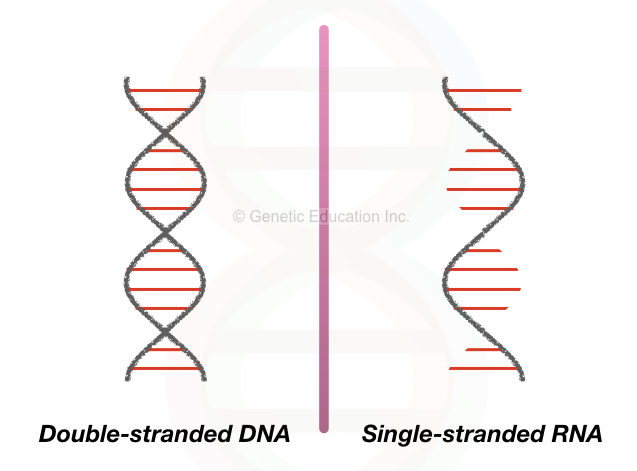
Why DNA is double-stranded? well, it is still a mystery but scientists believe that the DNA is more susceptible to damage- it is the genetic material in almost all living entities. Thus if one of the strands is damaged, a second strand can be used to repair it or form another complementary strand like it.
Interestingly, some double-stranded RNAs are also found in eukaryotes as well- called microRNA or siRNA.
Functionally, the microRNA can’t form protein, instead, it helps in regulating gene expression through RNA interference mechanism. The dsRNA is present in very low quantity.
Length:
“The length of the DNA is much longer in comparison to the RNA”.
A genome of us contains coding and non-coding both types of DNA- arranged on chromosomes.
If we stretch all the DNA of a cell it is actually 3 meters long. Hence it is very important to fit it inside the cell. DNA packaging allows to arrange it on chromosomes and fit inside the cell.
Contrary to this, the RNA is a final functional product transcribed from a DNA therefore it is much shorter than the DNA (Other non-coding sequences are removed).
The entire human genome contains 3.2 billion base pairs while if we consider the total RNA of a cell, it is only several kb long.
Sugar:
Although both nucleic acids are almost similar, the DNA is made up of deoxyribose sugar while the RNA is made up of ribose sugar only.
The deoxyribose sugar lacks one oxygen molecule and carries a hydrogen atom instead of a hydroxyl group at carbon 2.
Contrary to this, ribose is a simple sugar that has an oxygen molecule with an additional hydroxyl group at carbon 2. See the image below,
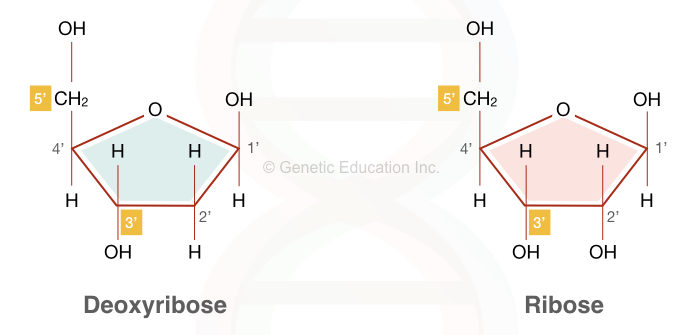
During the catalytic reaction, the difference of one oxygen makes it easy for enzymes to distinguish DNA from RNA.
Similarity: Both are five-carbon pentose sugar which forms a nucleotide by pairing with base and phosphate (sugar + base + phosphate = nucleotide).
Bases:
The DNA is made up of adenine, guanine, cytosine and thymine while the RNA is made up of adenine, guanine, cytosine and uracil.
As you noticed “Instead of thymine, the RNA contains uracil which is another major difference between DNA and RNA.”
Similarity: The DNA and RNA both are made up of nitrogenous bases- purines and pyrimidines.
Two DNA strands are linked together by hydrogen bonds- two between adenine and thymine and three between cytosine and guanine.
While if the RNA is double-stranded, it is linked together by hydrogen bonds- two hydrogen bonds between adenine and uracil and three hydrogen bonds between cytosine and guanine.

Location:
The DNA is located in the nucleus of a cell, while the RNA is synthesized in a cell but migrates to the cytoplasms and manufacture protein at the ribosome site.
However, some DNA is also present in membrane-bounded organelles such as mitochondria and chloroplast. Read more on organelle DNA here.
Synthesis difference between DNA vs RNA:
“The DNA is synthesized by an enzyme DNA polymerase during the process of replication while the RNA is synthesized by an enzyme RNA polymerase during transcription.”
“The process of RNA synthesis is de novo while the process of DNA synthesis required a short and single-stranded primer (not de novo).”
This clearly indicates that the (nucleic acid) primer is not necessary for the synthesis of RNA through RNA polymerase.
Related article: DNA Polymerase Vs RNA Polymerase.
Structurally, the RNA is made up of loops and stems while the DNA is a double-stranded coiled structure arranged on chromosomes. However, some DNA molecules also possess additional structural of tetraplex, quadruplex or alpha helix.
Some DNA is also present in circular and linear forms too.
The functional difference between DNA vs RNA:
The main function of DNA is storing and transferring information from one generation to another generation in a population. For that DNA replicates- becomes doubled and inherited to daughter cells.
Therefore, inherited from one generation to another.
On the other side, the function of RNA is to form a protein.
Actually, RNA collects the coding information from DNA through transcription and translates it into a chain of amino acids. (A long chain of amino acid- polypeptide chain, creates protein).
On the basis of that, another difference between both is that-
“The DNA is self-replicating while the RNA is synthesized from DNA only when it needed.”
Different types of DNA:
DNA in nature, found in five different forms- A-DNA, B-DNA, C-DNA, D-DNA and Z-DNA.
The B form DNA is found in almost all living organisms and is most prevalent in nature. It is right-handed DNA with a major and minor groove. It has 10.5 base pairs per helical turn.
The A-form DNA is also right-handed but the helix is wider than the B-form DNA. It has the major and minor groove and has 11 base pairs per helical turn.
The z-form DNA is left-handed and does not have the major groove in it. It has 12 base pairs per helical turn.
The C-form DNA is a very rare varients having 9.33 base pairs per helical turn. Even, the D-form is extremely rare.
Different types of RNA:
mRNA: a messenger RNA encodes amino acid for creating a polypeptide chain.
tRNA: a transfer RNA helps to transfer amino acid to the site of translation henceforth, in the cytoplasm at the ribosome.
rRNA: a cytoplasmic ribosomal RNA is a component of ribosome required for protein synthesis.
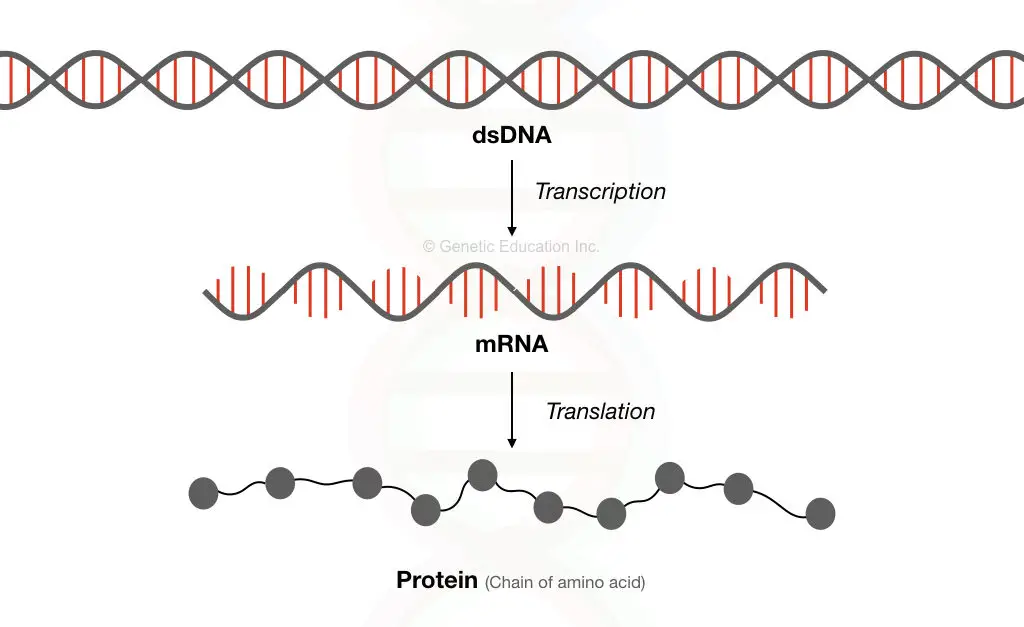
Other smaller RNAs: other smaller fragments of dsRNA called microRNA and siRNA are also present in a cell.
Several more differences:
“The alkaline condition is more favorable for a DNA henceforth, the DNA is more stable under alkaline condition while the RNA is not.”
The DNA is made up of the manor and minor groove, the minor groove doesn’t allow enzyme binding, so it is very difficult for nuclease to bind with DNA and destroy it.
Contrary to this, the RNA is single-stranded and does not have a minor groove structure, a nuclease can attack it easily and destroy it.
However, RNA break-down and re-synthesis continuously occur in a cell, faster than DNA.
“The DNA is less reactive because of the stability provided by the C-H bonds of deoxyribose while the RNA is more reactive due to the O-H bonds of ribose.”
“A genome- made up of the DNA carries some methylated DNA as well which can neither express. On the other side, none of the RNAs is methylated.”
Another important difference between DNA and RNA is the susceptibility to ultraviolet rays.
The Ultraviolet rays- UV rays are one of the common types of natural mutagens that damages our DNA.
A mutagen UV damages our DNA and causes genetic mutations. The DNA is more susceptible to UV damage while the RNA is resistant to UV, comparatively.
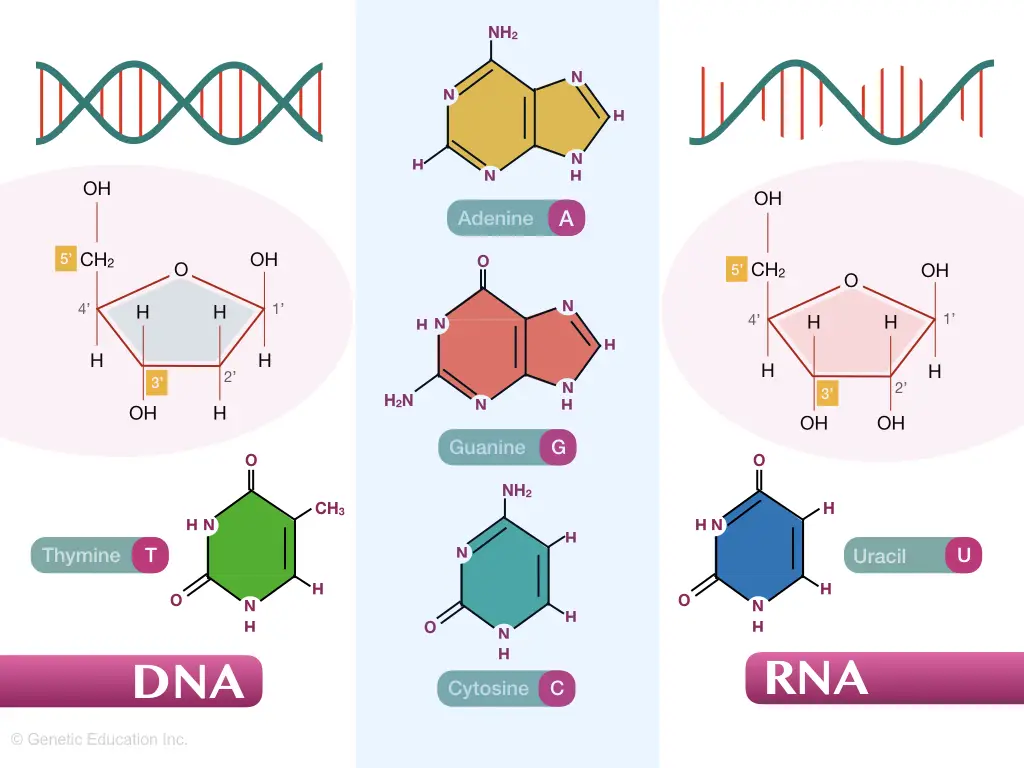
Some more…
DNA is double-stranded and longer while the RNA is shorter and single-stranded, hence the RNA migrates above DNA in a gel. If you see a smear above the DNA band in a gel, your DNA is contaminated with the RNA.
Extracting DNA is even easier than RNA; RNase presents everywhere even on our hands and on other instruments thus RNA can easily be broken down or destroyed during isolation.
An additional step of reverse transcription is required during the RNA sequencing but not in DNA sequencing. The extracted RNA is first reverse-transcribed to the cDNA and then processed for sequencing.
Some of the different types of RNA are summarised here:
| Abbreviation | RNA types | Function |
| mRNA | Messenger RNA | Codes for protein |
| tRNA | Transfer RNA | Transfer amino acid to the site of translation. |
| rRNA | Ribosomal RNA | Catalyze the translation reaction |
| miRNA | microRNA | Gene regulation |
| siRNA | Small interfering RNA | Gene regulation and maintaining gene expression. |
| LncRNA | Long non-coding RNA | Transcriptional regulation and epigenetic regulations. |
| snRNA | Small nuclear RNA | Helps in mRNA splicing and related functions |
| snoRNA | Small nucleolar RNA | Helps in RNA nucleotide modification |
| piRNA | Piwi-intercalating RNA | Function in defense against transposon; transposon defense system. |
| scaRNA | Small Cajal body-specific RNA | Also helps in nucleotide modifications (a type of snoRNA). |
| shRNA | Small hairpin RNA | Synthetic RNA molecule helps in gene regulation and controlling gene expression. |
These are some of the Differences which you should know about DNA and RNA. Now let’s talk about similarities.
Similarities between DNA and RNA:
Obviously, both are from the class of macromolecules called nucleic acid and are genetic material.
Both are made up of five carbon- pentose sugar, phosphate and nitrogenous bases.
Both are polynucleotide chains made up of a single nucleotide unit or monomers.
Both biomolecules are synthesized by the polymerase enzyme.
Practically, both DNA and RNA can be precipitated using alcohol.
DNA in a nutshell:
DNA is an inheritance unit made up of nucleotides and present in all living organisms on earth. A functional unit of DNA is known as a gene, an alternative form of a gene- alleles are located on chromosomes.
The B-form DNA with right-handed symmetry is more prevalently found in almost all organisms.
The entire haploid set of all DNA is called a genome, our genome contains approximately 3.2 billion base pairs.
Article to read: DNA story: The structure and function of DNA.
RNA in a nutshell:
The RNA is a single-stranded nucleic acid molecule, also made up of sugar, phosphate and nitrogenous bases. The mRNA is transcribed from the DNA which encodes for a long chain of amino acids.
Instead of thymine, the RNA has uracil in place of it and synthesized by RNA polymerase.
In addition to this, RNA is a genetic material in some of the viruses called retroviruses.
Read on RNA: RNA structure and function.
Summary of the article:
| Comparision | DNA | RNA |
| Name | Deoxyribose nucleic acid | Ribose nucleic acid |
| Function | Storing and transferring information | Coding protein |
| Nitrogenous base | Adenine, thymine, cytosine and guanine. | Adenine, uracil, cytosine and guanine. |
| Helical form | B-form right-handed DNA | A-form single-stranded RNA. |
| Groove | Major and minor grooves | Only major grooves. |
| Synthesis | During replication by DNA polymerase | During transcription by RNA polymerase |
| Sugar | Deoxyribose | D-ribose |
| Length | up to 3 meters (entire genome) | Much shorter than DNA. |
| Location | Found in the nucleus (mitochondria and chloroplast). | Synthesized in nucleus and function in cytoplasm. |
| Nuclease activity | Less prone to nuclease | More prone to nuclease. |
Related article: Genetics Basics: A Beginners Guide To Learn Genetics.
Conclusion:
Scientists believe that the RNA is evolved first, before DNA and thus it is now present in some of the viruses. However, the exact reason why DNA is evolved is still unknown, because the final polypeptide product is translated from the mRNA- with the help of tRNA and rRNA.
Nevertheless, the major difference between DNA vs RNA is not the bases in it, but, the sugar that makes both unique. The deoxy sugar gives power to DNA and makes it more stable and less reactive while due to the ribose, the RNA is more reactive and can be broken down easily by nucleases.
Quiz For You:
(A) What is not present in DNA?
- Adenine
- Guanine
- Uracil
- Thymine
(B) RNA is synthesized by?
- DNA polymerase
- RNA polymerase
- Ligase
- Helicase
(C) RNA is the genetic material of several?
- Bacteria
- Plants
- Nematodes
- Viruses
(D) DNA is made up of _______
- Polynucleotide chain
- Polypeptide chain
- Carboxylic chain
- Amino acid chain
(E) What is a nucleotide?
- Sugar + base
- Sugar + phosphate
- Sugar + phosphate + base
- Base + phosphate
Answers:
(A): 3- Uracil. (B): 2- RNA polymerase. (C): 4- Viruses. (D): 1-Polynucleotide chain. (E): 3-Sugar + phosphate + base.
Resources:
- Alberts B, Johnson A, Lewis J, et al. Molecular Biology of the Cell. 4th edition. New York: Garland Science; 2002. The Structure and Function of DNA. Available from: https://www.ncbi.nlm.nih.gov/books/NBK26821/.
- Alberts B, Johnson A, Lewis J, et al. Molecular Biology of the Cell. 4th edition. New York: Garland Science; 2002. From DNA to RNA. Available from: https://www.ncbi.nlm.nih.gov/books/NBK26887/.
- Alberts B, Johnson A, Lewis J, et al. Molecular Biology of the Cell. 4th edition. New York: Garland Science; 2002. From RNA to Protein. Available from: https://www.ncbi.nlm.nih.gov/books/NBK26829/.
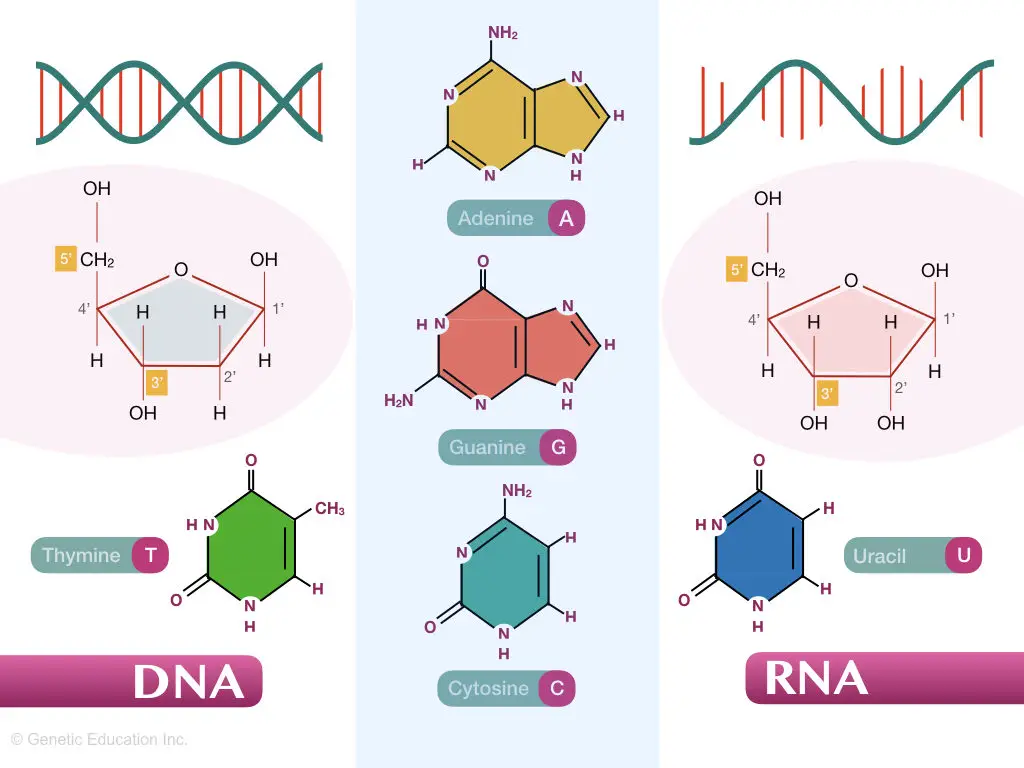


Thank you so much
Welcome